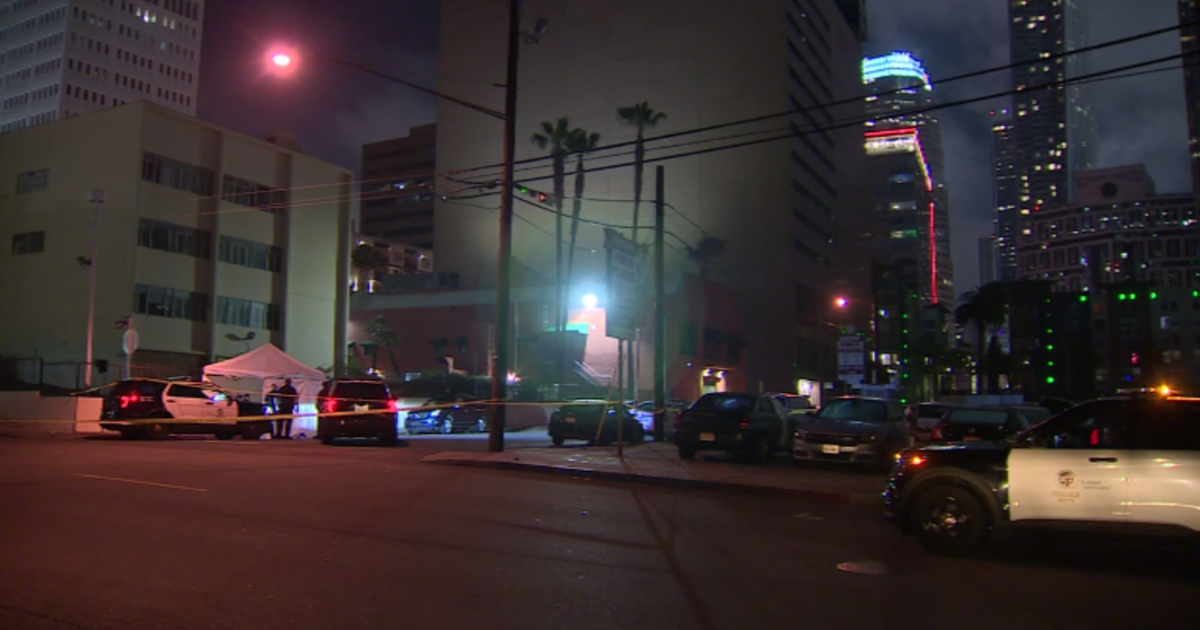MAE SAI, Thailand (CBS News) — CBS News correspondent Anna Werner reports from northern Thailand that "everyone is praying" from the boys trapped in a cave for more than two weeks.
"I think there is a sort of community spirity of everyone coming together," Werner said.
Werner said that when she told people she is a reporter on the story, "immediately you have their attention, because everyone is so focused on this story."
A rice farmer told The New York Times that she already prepared her soil for the season, but when she returned from volunteering to help the boys, her fields had been flooded with water from the cave. She said she is not concerned about that, because the boys were found alive.
"I am more than willing to have my rice fields flooded as long as the children are safe," she told the Times. "The boys are like my children."
Meteorologist: If heavy rains start, could bring water currents
Meteorologist Craig Setzer from CBS Miami tells CBSN that the major concern from a weather perspective is that if area is faced with heavy rains, there could be water new currents in the cave
"Anyone who knows scuba diving knows how incredibly strong even a little bit of current can be," Setzer said. "It quickly exhausts you."
Setzer noted that since it is the rainy season in Thailand, rescuers had to take advantage of the open window, since it's more likely to be raining on any given day.
There were cloudy skies in Chiang Rai Monday, after a night in which heavy monsoon rains lashed the mountainous region for several hours. It was not immediately clear Monday how the overnight rains had impacted water levels inside the flooded cave.
Officials have said storms forecast for Chiang Rai province in Thailand's far north had factored into their decision to go ahead with a complicated and dangerous plan to have the boys and their coach dive out of the cave.
Thai PM expected in Chiang Rai Monday night
Thai Prime Minister Prayuth Chan-ocha is expected to come Monday night to Chiang Rai, where nine people remained trapped in a cave.
Prayuth was the leader of a miliatry junta that seized power in 2014. He visited with relatives and rescue officials last week, a move that was criticized by some as opportunistic as his governmentfaced pro-democracy protests in the capital Bangkok in recent months, Reuters reports.
Thai media reports coach is one of those rescued
Thai media reported Monday that the 25-year-old soccer coach was among those who were rescued, CBS News foreign correspondent Ben Tracy reports. Tracy said that while that may seem odd, it's been reported for days that the coach was actually in the worst shape of those trapped in the cave, since he had been giving the boys all the food and water he had on him.
One of the four people rescued was airlifted to a hospital, the rest were taken by ambulance. They will be evaulated at the hospital for the next 3-5 days.
Ex-U.S. Navy SEAL explains why so many divers are involved
Dave Sear, a former U.S. Navy SEAL, joined CBSN to explain why there are 90 divers involved in the rescue mission and what kind of assistance the U.S. can offer Thailand officials. Fifty of the rescuers are from Thailand and 40 others are from across the world. Sear said some of the divers are likely staging oxygen tanks and fixing lines of rope along the cave.
"A rope will go along the entire cave to guide them so they can find their way out of the cave. They will make sure it is in place. Then you are going to stage oxygen bottles or air bottles, depending on what they are using, along that route so that they can switch out as they go. They will have bottles there so they can refresh them, and put new bottles on. The other divers will get them out and replace them," Sear said.
Sear said the U.S. will likely offer planning and logistic experience in terms of coordinating equipment needed for the mission."We have some of the best divers in the world and, we can hook them up with internet, Skype, mobile stations and power sources," he said.
"You can't make a horror movie that would even compare"
Anmar Mirza, national coordinator of the National Cave Rescue Mission, says the complexity of the rescue is off the charts.
"This is the most scary situation that a person could go through, said Anmar Mirza, national coordinator of the National Cave Rescue Mission. "You can't make a horror movie that would even compare... I've been involved in cave rescues for 30 years and I cannot even think of one that is this complicated."
"The trust factor between the children and diver makes it -- it's probably 90 percent of what gets them out of the cave," Mirza said.
An international team has taken shifts bringing them food, medical supplies and comforting letters from their parents. Their soccer coach even taught them to meditate to stay calm.
"The good news is that the first phase was successful, so they had an opportunity to show it works," Mirza said. "It's still dangerous but it's much better odds for the remaining kids to come out now because of those initial ones."
Challenging rescue: "Almost a perfect storm"
Edd Sorenson, Safety Officer for National Speleological Society-Cave Diving Section, told CBSN the challenges rescuers face. Chief among them: The water, especially for kids who don't swim, the lack of experience with diving, and zero-visibility.
Communication about planning is an issue, given the international scope of the rescue effort. And that's before the actual rescue attempt. "Communication in the water is extremely difficult," said Sorenson. "That's one of the things we teach in cave diving. There's no talking. So everything has to be done, usually by hand signals. But in zero visibility, it's has to be touch contact."
The need to keep calm is also crucial. "That's one of the biggest issues with a lot of divers in cave training is being able to handle stressful situations. That's why in cave diving, you can't even start your very first entry-level cavern until you're at least 18 years of age."
Sorenson also described the unique conditions that make cave diving so difficult. "Every cave is different. They are not just a tunnel to go through. It's fallen down boulder piles. There's hazards beyond hazards. And when you're in zero visibility, you have to follow that line. You let go of that line, you may never get out."
How will doctors treat the rescued boys?
Dr. Robert Glatter, an emergency physician at Lenox Hill Hospital in New York, joined CBSN on Sunday to talk about how health officials will treat the boys who have been rescued, as well as those still trapped inside. He said doctors will test them for hypothermia and assess their mental status when the arrive at the hospital.
"The way we all experience things is different than they are in the mind of children -- they may be more vulnerable in the short term but in the longer term picture, the prognosis is excellent. We assume that they can recover and that with proper counseling as well as love and support, they will likely come out of this OK," Glatter said.
He said the children will likely be watched for a short period of time to ensure their kidney function is normal and their blood work is favorable.
"As long as they are eating, their vital signs are fine, their spirits are fine, they will likely be released after a 12-24 hour observation-type period," he continued. "This is based on the fact that they're doing well. I think it is really an minute-by-minute assessment and day-by-day assessment."
Engineers sent by Elon Musk remain on standby
The California tunnel company run by Elon Musk is continuing to maintain a presence at the Thai cave. Sam Teller, spokesman for Boring Co., said Sunday that the company has four engineers who are "offering support in any way the government deems useful."
Musk tweeted early Saturday that he was working with a team from his SpaceX rocket company to build a "tiny, kid-size submarine" to transport the children. But Saturday night, he tweeted that the cave was now closed for the rescue by divers. "Will continue testing in LA in case needed later or somewhere else in the future," he wrote.
Musk says the sub would be light enough to be carried by two divers and small enough to get through narrow cave gaps.
Rescue operation going "better than expected," next phase to begin in 10-20 hours
A Thai official says the next phase of the operation to rescue the rest of the trapped boys will begin in 10 to 20 hours as rescuers replenish their oxygen tanks.
Speaking to reporters at a briefing near the cave on Sunday night, Chiang Rai provincial acting Gov. Narongsak Osatanakorn said the healthiest boys were taken out first, with the first two emerging at 5:40 p.m. and 5:50 p.m. local time, or 6:40 a.m. ET. Two others were brought out about two hours later.
Narongsak said the operation was going "better than expected." The four freed boys have been transported to the hospital, where they will be reunited with their families. Their condition was not known.
Trump says U.S. "working very closely" with Thai government on rescue
In his first tweet of the day, President Trump says the U.S. is working with Thai officials in the rescue operation:
Four of the 12 boys are now out of the cave complex, rescue officials told reporters during a briefing Sunday. The Thai navy SEALs say two were transported by ambulance from the cave, one of whom was airlifted in a helicopter.
The SEALs say five of the 18 rescue divers were Thai, with American, Australian and Japanese divers assisting in the effort.
At least 2 boys reportedly emerge safely from cave
Multiple reports citing local officials say at least two of the trapped boys have emerged safely from the cave, arriving much sooner than expected. Reuters reports a local rescue official said the boys are being examined.
"Two kids are out. They are currently at the field hospital near the cave," Tossathep Boonthong, chief of Chiang Rai's health department, told Reuters.
The AP reports two ambulances were seen Sunday evening leaving the cave and drove to a nearby helipad where a helicopter was seen taking off. Officials had said earlier that helicopters were on standby to take anyone rescued from the cave to a hospital.
Thai government releases details on rescue effort
The Thai government has released a graphic with details of the rescue effort, BBC News' Nick Beake reports. The graphic says that two divers are assigned to each boy and are being guided by rope.
Thai navy SEALs vow to bring boys back safely in Facebook post
Thai navy SEALs vow to bring boys back safely in Facebook post
The Thai navy SEALs, who have been spearheading the rescue effort, have posted a photo on their Facebook page with a vow to bring the trapped team home from a flooded cave.
The unit says in a message: "We, the Thai team and the international team, will bring the Wild Boars home." That's the name of the young boys' team.
Water level in cave has been brought down to level where boys can walk for some of journey
Authorities felt they had a "small window of time to act" to rescue the boys and their coach, CBS News' Ben Tracy reports from Chiang Rai.
Two divers will be assigned to each child to help them navigate the dangerous, narrow passageways. CBS News has also learned that water level inside the cave has been brought down to a level where the boys can walk for much for the journey rather than swim. That will make the operation less risky.
Heavy rain is in the forecast and oxygen levels in the cave have been dropping to dangerous levels.
"A really really tricky dive": A look at some of the rescue's challenges
The rescue operation to save 12 boys and their coach from a cave will be "really, really tricky," said Sink or Swim Scbua instructor Brent Clevenger in an interview with CBSN on Saturday. Clevenger said the biggest concerns look like the tight passageways, strong currents and low visiblity.
It's estimated that it will take the divers several hours to reach the boys, and then several hours to return. Each rescue is estimated to take about 11 hours, officials said.
As Clevenger noted to CBSN, a diver will need to change tanks, making it a "really, really tricky dive for an experienced diver on his own."
Clevenger also said another concern will be the oxygen levels. If carbon dioxide builds up and oxygen runs low, it could potentially cause panic, unconsciousness and even death. On Thursday, a former Thai Navy SEAL who was part of the rescue mission died from lack of oxygen, authorities.
Of course, the boys are only now learning to dive, and Clevenger said he normally teaches boys to dive in shallow water, so they can stand up if they panic. In this case, the boys will be going through passageways where they can't stand up. And even if the boys are with experienced divers, the narrow passageways will make it hard for the experienced divers to check on any boy who might be panicking.
"I think the best rescue option is to teach them to dive, try to get multiple divers watching one boy at a time and just do the best with it," Clevenger said. "I would say there's not a good option, there's just a bset option that we have, but like I said, there's no good option at this point."
Rescue mission could take days
The rescue operation began at 10 a.m. local time, and it will take at least 11 hours for the first person to be rescued, Chiang Rai acting Gov. Narongsak Osottanakorn said. The rescue mission could take several days.
Both the trapped group and their families had been informed of the plan, BBC News reports.
The boys will be medically evaluated when they are out of the cave. There are 13 ambulances and helicopaters ready to transport the boys to local hospitals if necessary. The nearest hospital is 15 minutes away by helicopter, BBC News reports.
Narongsak said the boys are ready and willing to be brought out. "Their hearts are strong and determined," he said.
"Today is D-Day," Thai governor says
A Thai governor says the operation to bring out the boys and their soccer coach from deep inside a cave where they have been trapped for two weeks has begun. The acting Chiang Rai governor has told reporters "today is D-Day" with 13 foreigner and five Thai divers taking part in the rescue.
He says the divers went in at 10 a.m. and the boys will gradually come out accompanied by two divers each. He says the earliest they will come out is 9 p.m. Sunday (10 a.m. ET). The only way to bring them out is by navigating dark and tight passageways filled with muddy water and strong currents, as well as oxygen-depleted air.
Experienced cave rescue experts consider an underwater escape a last resort, especially with people untrained in diving, as the boys are. The path out is considered especially complicated because of twists and turns in narrow flooded passages.
But the governor supervising the mission said earlier that mild weather and falling water levels over the last few days had created optimal conditions for an underwater evacuation that won't last if it rains again.
Dozens of divers arrive at cave
Dozens of divers arrived at the Tham Luang cave on Sunday morning and officials set up more tarpaulin sheets blocking off the divers' operating area.
Officials ask media to clear out
Thai authorities asked media to clear out of the area around the entrance of the cave. "Everyone who is not involved with the operations has to get out of the area immediately," police announced via loudspeaker, AFP reports.
"From the situation assessment, we need to use the area to help victims," police said.



